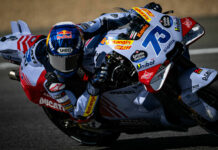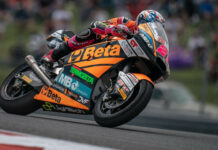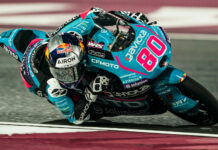Copyright 2003, Roadracing World Publishing, Inc.
FIRST PERSON/OPINION
Via e-mail:
One of the things that has always attracted me to professional sports in general and motor sports specifically, is the level of commitment and concentration that the top athletes must attain and maintain throughout the course of their seasons. This is perhaps nowhere more important than motorcycle road racing. Call it what you will; getting your “race face” on, being “in the zone”, for the top riders it is an absolute necessity that they operate at optimum levels for extended periods of time. To do this, one must have unquestioning faith in one’s equipment. A confidence that allows peak performance with no distraction in a sport where a miscalculation at speed can cause grave harm not only to the rider, but his fellow competitors. This elevated state of “tune” is a crucial component to a successful season. It can be the difference between just being on the front row and taking pole position. Being in the points hunt and winning a championship. Most importantly, it can be the difference between finishing the race and crashing out.
It seems as if there is a sickness in the AMA paddock right now. A sickness that up to now has shown no signs of getting better. It is a creeping disease borne of a lack of confidence in one’s equipment.
The sickness began to appear this past AMA season, with multiple Dunlop riders having tire problems at various tracks. Tires were chunking at an alarming rate. Dunlop couldn’t (and, I think it’s important to point out, didn’t) point the finger at riders who were traditionally hard on tires (Kurtis Roberts), bikes that had too much horsepower (the GSXR’s) or tracks that were just too hard on tires (Daytona). The failures happened to different riders at different tracks, and in different conditions. They occurred on four cylinders and twins and in both the early and late stages of races. Eventually and maybe inevitably, one let go with a bang. Mat Mladin’s wild ride at Road Atlanta was a butt-clencher just to watch on television. I can only imagine what it felt like from his perspective. Thankfully, he rode it out (mostly) and was able to walk away from what could have been a major incident. Subsequent events would prove that Mladin’s frightening episode was a harbinger of things to come.
Flash forward to Daytona, October of this year. Ben Spies crashes spectacularly at 186 mph after a rear Dunlop fails. My initial reaction was “what the hell”? “Dunlop has been having problems all year and presumably working diligently to solve the issues, and this is what they came up with”? Thankfully, Spies walks away from the crash with relatively minor injuries. Surely this is the wake-up call that Dunlop needs to make whatever effort necessary to prevent this sort of thing from happening again. Whatever resources they have at their disposal are surely being used to eliminate this threat to the safety of the riders. I believed this. I believed it because Dunlop is a reputable company with a storied history in motor sports. Not only here in America with the AMA, but all over the world in many forms of racing. They have a guy in Jim Allen who has the experience and intelligence to effectively communicate with the riders and teams and relay their needs to the Dunlop factory. Dunlop employs some of the most cutting edge R&D procedures and manufacturing techniques in the world. They have the resources and knowledge necessary to effectively eliminate failures in their products. All of the components were in place. That’s why I believed in Dunlop. That’s why I was virtually certain nothing like what happened to Ben Spies would happen again.
I was certain until yesterday when, during tire testing, Jason DiSalvo skipped down the Daytona pavement at better than 180 mph without his motorcycle after another Dunlop slick came apart at speed. Like Spies, DiSalvo seems to crash well and walks away with only a headache and some toasty skin. Dunlop pulls the plug on further use of their slicks and asks all of the teams to return any slick tires they had received for the test.
There seems no doubt that the problems that plagued Dunlop last season remain a problem still.
So, where does this leave Dunlop, and where does it leave the teams and riders who have to come to Daytona, three short months from now, and compete lap after lap at speeds approaching 200 mph?
The way I see it, there are only two possible scenarios. In scenario number one, Dunlop provides a tire that is capable of handling the rigors of sustained speed on the Daytona banking by March. In Scenario two, the Superbikes (and quite possibly the Superstock bikes) don’t race at Daytona this year. As a racer and race fan, I hate to envision March without the Superbikes running at Daytona. Logically, however, I find this scenario to be as likely as Dunlop coming up with a solution to the problem in time. If they have had all of last season and the off season until now to fix the problem, why should I assume that their efforts in the next 90 days will prove more fruitful?
At his point, there are perhaps more questions than answers. Is Dunlop providing a faulty product? Are the bikes getting too powerful, too heavy, or both? Are the teams and riders partially at fault for constantly pushing Dunlop to provide higher and higher levels of grip in their never ending quest for lower lap times?
I think Jim Allen hit the nail on the head when he suggested on a couple of occasions, and I’m paraphrasing here, that maybe Dunlop hadn’t done a good enough job just telling the riders: “Here you go. This is what you have to race on”. In other words, create a product you know is safe and distribute it that way whether the riders and teams like it or not. I know Dunlop has the capability to construct a tire that will last at Daytona. I just can’t buy the weight and speed argument. If airline tires can hold together under the weight of a fully loaded jumbo jet landing, a motorcycle tire can be constructed that will stand up to 200 mph on the high banks. Will it have to be a harder compound than the teams want? Probably. Will it need to have a thicker/heavier carcass with more material? Most assuredly. Will it have less overall grip in the infield and raise lap times? No doubt. Will the competition or spectator’s enjoyment suffer? Not a bit.
Motorcycle racing is inherently dangerous. No reasonable person could argue otherwise. The riders accept this risk as part of their job and do everything in their power to reduce the chances of bringing harm on themselves or others during a race. Their close partners in this endeavor are the equipment manufacturers, especially their tire supplier. The latest Superbikes are making close to (some say more than) 200 hp and weigh less than 400 lbs. They circulate the track and rail through the corners on a small patch of rubber that is maybe the size if a silver dollar. That contact patch is the rider’s very lifeline when competing. Sending him or her out on a tire that has a known tendency to fail under certain conditions is akin to sending a soldier into battle with a gun that might blow up in his hand. It could cost him his life.
Tony Shortman
Las Vegas, Nevada
FIRST PERSON/OPINION
Via e-mail:
I’m going to have to comment on this one. What a load of bollocks! The only people afraid at Daytona are the ones who are wearing the Dunlop skins on their bikes. Send ’em out with Pirelli or Michelin and you wouldn’t be reporting this at all. If I remember correctly, Daytona wasn’t the only track in which tire failures happened last year.
Dunlop….you’ve got a problem I’d say. Especially with the confidence of your riders.
Darick Pash
CMRA Amateur #123
Abilene, Texas
FIRST PERSON/OPINION
Via e-mail:
I’ve been reading about Jason DiSalvo’s tire failure yesterday at DIS and the uproar it caused with the riders. I agree with them that Superbikes and Superstock bikes should no longer race at Daytona. The bikes have become too powerful and it’s obvious tire technology has not kept up. It’s become too much of a safety issue.
I would hate for there not to be a Daytona 200 next year, however. That’s always been my favorite race of the season to watch. So as a compromise, why not make the 200 a Supersport or Formula Extreme race? The 600s don’t have the tire problems the bigger bikes have, and the racing would be just as good, if not better!
Mark Dolente
CCS #927
Clifton Heights, Pennsylvania
FIRST PERSON/OPINION
Via e-mail:
Regarding Mladin and Daytona, I know there are those who will say he doesn’t want to race at Daytona because of the times the other teams are turning, but does that make his point less valid? The track is not an accident waiting to happen – the accidents have happened! The track is now a massive injury (or injuries) or fatality (or fatalities) waiting to happen. If one of these tire failures happens in a pack, then what?
It is time for either a MASSIVE layout change at Daytona or to remove the track from the schedule. It is an aberration as a track now with it’s layout, and has little to do with the rest of the AMA schedule, yet requires a HUGE layout of cash to run. Want to save the privateers (and factories, for that matter – and tire manufacturers as well) a bundle of cash? Scratch this race in it’s current format before someone is killed.
One man’s opinion – no wait, it’s Mat’s, too! And Spies, I believe, as well. I’m guessing DiSalvo may agree as well…
Gary Hilliard
Felton, Delaware
Readers React To Dunlop Tires Exploding At Daytona, And To Mat Mladin’s Comments
Readers React To Dunlop Tires Exploding At Daytona, And To Mat Mladin’s Comments
© 2003, Roadracing World Publishing, Inc.






